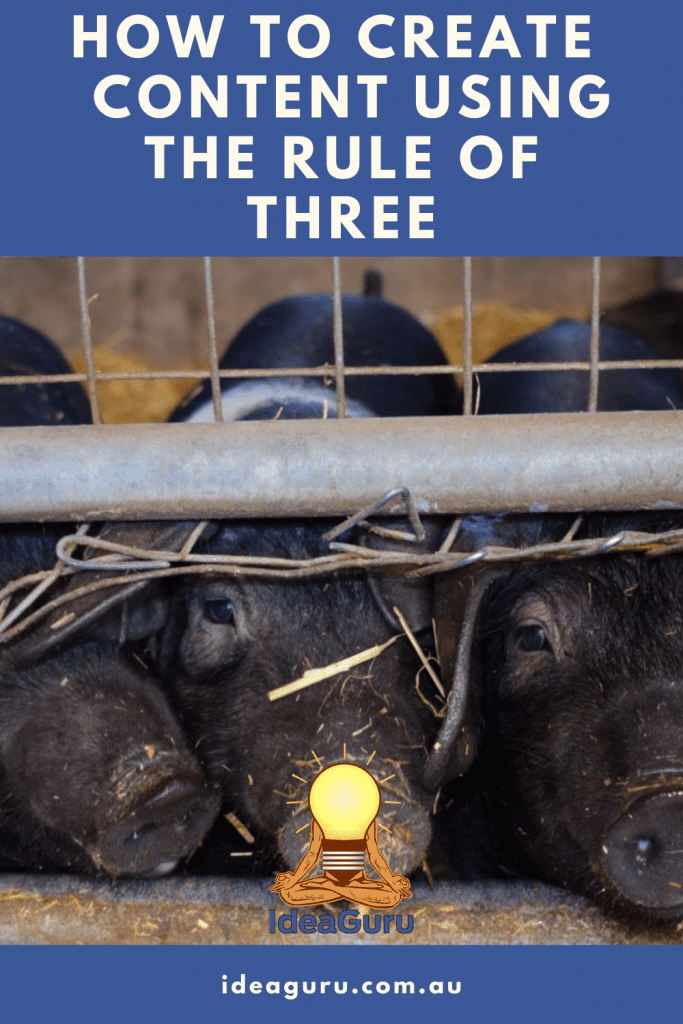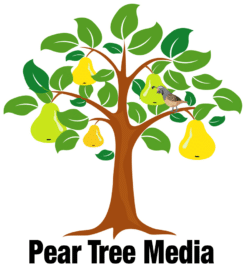Table of Contents
Have you heard of the “Rule of Three” when it comes to writing? The “Rule of Three” is a principle of persuasive writing that has been around for centuries, yet many people today have never heard of it, even though they consume content adhering to this rule daily.
Don’t believe me?
Have you ever heard of the Three Little Pigs? Seen a Mars bar add that told you a Mars a day would help you work, rest, and play? Maybe you grew up in Australia in the 90’s and constantly got told to Slip-Slop-Slap perhaps?
There you go.
So what is it about the number “three” that makes it so memorable? Well, there is a cadence to the number…a symmetry. First, second, third…beginning, middle, end. It is balanced, it rolls off the tongue, and there is something romantically satisfying about the hero saving the day at the end of the third act.
Throughout human history, the “Rule of Three” has been a recurring theme. Mark Anthony asked that “friends, Romans and countrymen” lend him their ears. As Thomas Jefferson worked on the Declaration of Independence, he leaned heavily upon other writers when he penned the iconic phrase “life, liberty and the pursuit of happiness.” And Christians the world over give praise to the “Father, Son and the Holy Spirit.” With a little hard work, and a whole lot of “blood, sweat and tears,” we can learn how to create engaging content using the “Rule of Three.”
Principles of the Rule of Three
When we are exposed to information, we retain it better when it is presented in clusters of three. (Just look at the examples in the above paragraphs.) Cadence, rhythm and balance are essential structural elements when crafting a memorable sentence.
- Cadence is defined as: A modulation in reading aloud as implied by the structure and ordering of words and phrases in written text. / A sequence of notes or chords comprising the close of a musical phrase.
- Rhythm is defined as: A strong, regular repeated pattern of movement or sound. / The systematic arrangement of musical sounds, principally according to duration and periodic stress. / The measured flow of words and phrases in verse or prowse as determined by the relation of long and short or stressed and unstressed syllables.
- Balance is defined as: An even distribution of weight enabling someone or something to remain upright and steady. / A condition in which different elements are equal or in the correct proportions. / Stability of one’s mind or feelings.
Content Formatting
“Listicles” that include three bullet-pointed items are typically the most attractive for readers, as well as search engines. For the human brain, “three” is a magic number (think of old superstitions like ‘well things always happen in three’s). Two is practical for balance purposes. However, it limits itself as either-or, one or the other, or right or wrong. Four is also practical, yet there is a sterility to it. Four right turns makes a circle. Four quarters make a dollar, and it makes a football game. But there’s no romance, and the poetry seems forced.
A list post that uses three bullet points tends to get right to the point. There just isn’t room for all the fluff and filler. Information gets delivered in a much more efficient way, and the cadence, rhythm and balance make it easier to retain.
Structural examples
- The Three Little Pigs: The first act features “Little Pig number one,” who builds his house out of straw. This sets up the story. The Big Bad Wolf blows down the house, moving the story forward. The second act builds tension when “Little Pig number two” builds a house of sticks. The Big Bad Wolf blows that house down as well, increasing suspense, and building towards the dramatic climax of the third act. “Little Pig number three” outsmarts the Big Bad Wolf, and breaks the pattern by building his house out of bricks The Big Bad Wolf huffed and puffed and blew. And it took the Three Little Pigs three different tries, but they won in the end.
- The Three Wise Men: The Christian Bible depicts the birth of Jesus Christ as taking place in a Bethlehem manger. Shortly thereafter, the new born baby was visited by a group of Magi. These Magi are commonly referred to as the “Three Wise Men.” These wise men presented the baby Jesus with three gifts: gold, myrrh and frankincense. This is used as a literary representation of the Holy Trinity: the Father, the Son and the Holy Spirit.
- Goldilocks and the Three Bears: Home intruder Goldilocks breaks into the bear’s home. She tries out the first bed she comes upon, only to find it too hard to sleep on. She finds a second bed and tries it out, only to discover that it is too hard. The third bed Goldilocks finds is just right, and she is able to fall asleep. When the bears return home, they discover the break in. They check the first bed, and then the second. They eventually locate Goldilocks in the third bed.
Ways to implement the Rule of Three in your work
- Hendiatris: We actually touched on this one earlier. (Friends, Romans, countrymen…life, liberty and the pursuit of happiness.) A hendiatris is when three compatible words are used together to express a single idea.
- Three Part Structure: This is a very simple concept: beginning, middle and end. Think of how we tell jokes. “A Rabbi, a Priest and a Minister walk into a bar…” Then something happens, and then the punchline.
- Tricolon: This is a fantastic way to create an elegant and memorable sentence structure. The idea is to group three words together, which compliment one another in both length and form. Take the Gettysburg Address for example. Using just 271 words, President Abraham Lincoln crafted one of the most poignant and quoted speeches ever delivered. “We cannot desecrate, we cannot consecrate, we cannot hallow this ground.”
How to Create Engaging Content Using the Rule of Three: The Conclusion
If you want to create great content for your social media, articles, and sales pages, a great place to start is with the “Rule of Three”
See what I just did there?
Let’s break it down into three simple to follow steps.
- The Beginning: Set the scene for what you’re about to teach someone by making an introduction that outlines the benefit, such as ‘By watching this video, you will learn exactly how to use the Rule of Three in your content…’
- The Middle: This is where you deliver on what you said you would in the intro. This is the meat, the gold nuggets, the whatever buzz word you like to use.
- The End: At the end of your piece of content you summarise the lesson you have just given, invite questions, and deliver your call to action (ie ask the person to click subscribe, follow you on social media, download your lead magnet).
It’s quite possible that you are already using the Rule of Three in your writing, even if you aren’t aware of it. Through sheer exposure, this rule has become ingrained into our speech patterns, and communication styles. Subconsciously we search for it. This is why content which makes full use of this strategy is more engaging. And now that you understand the Rule of Three, you can say that “you came, you saw and you conquered!”


